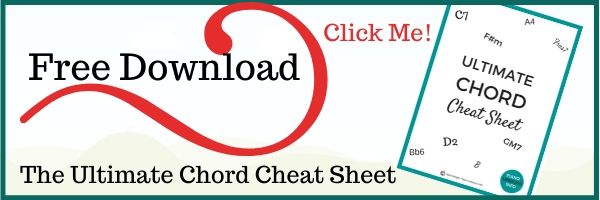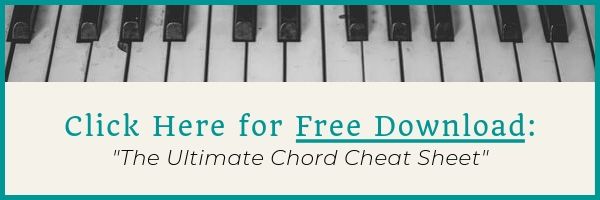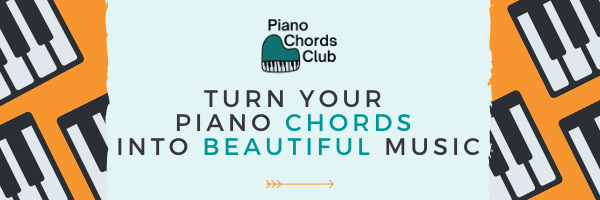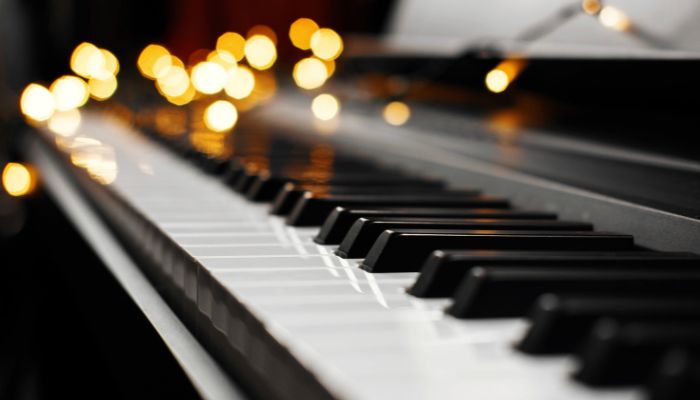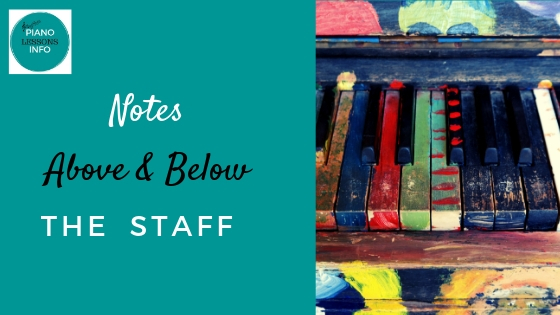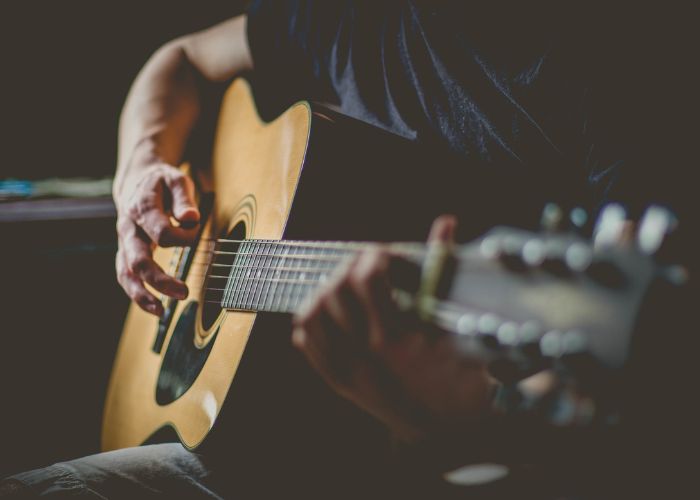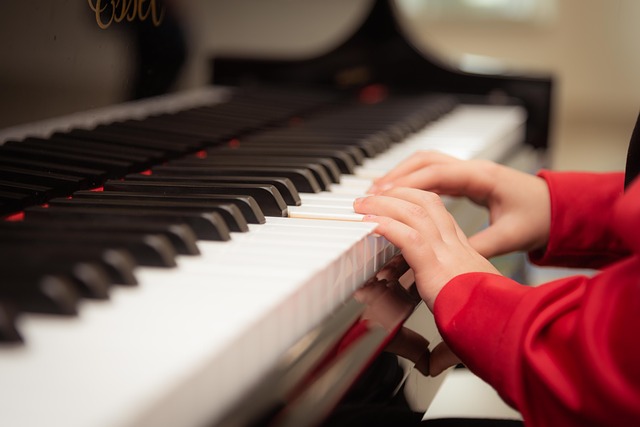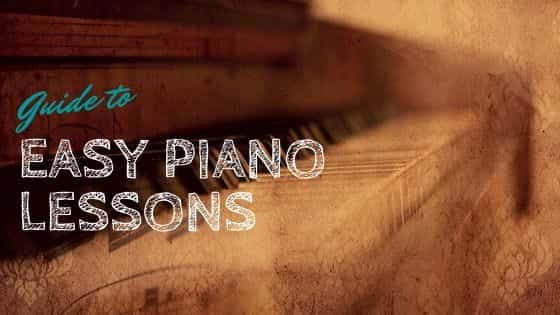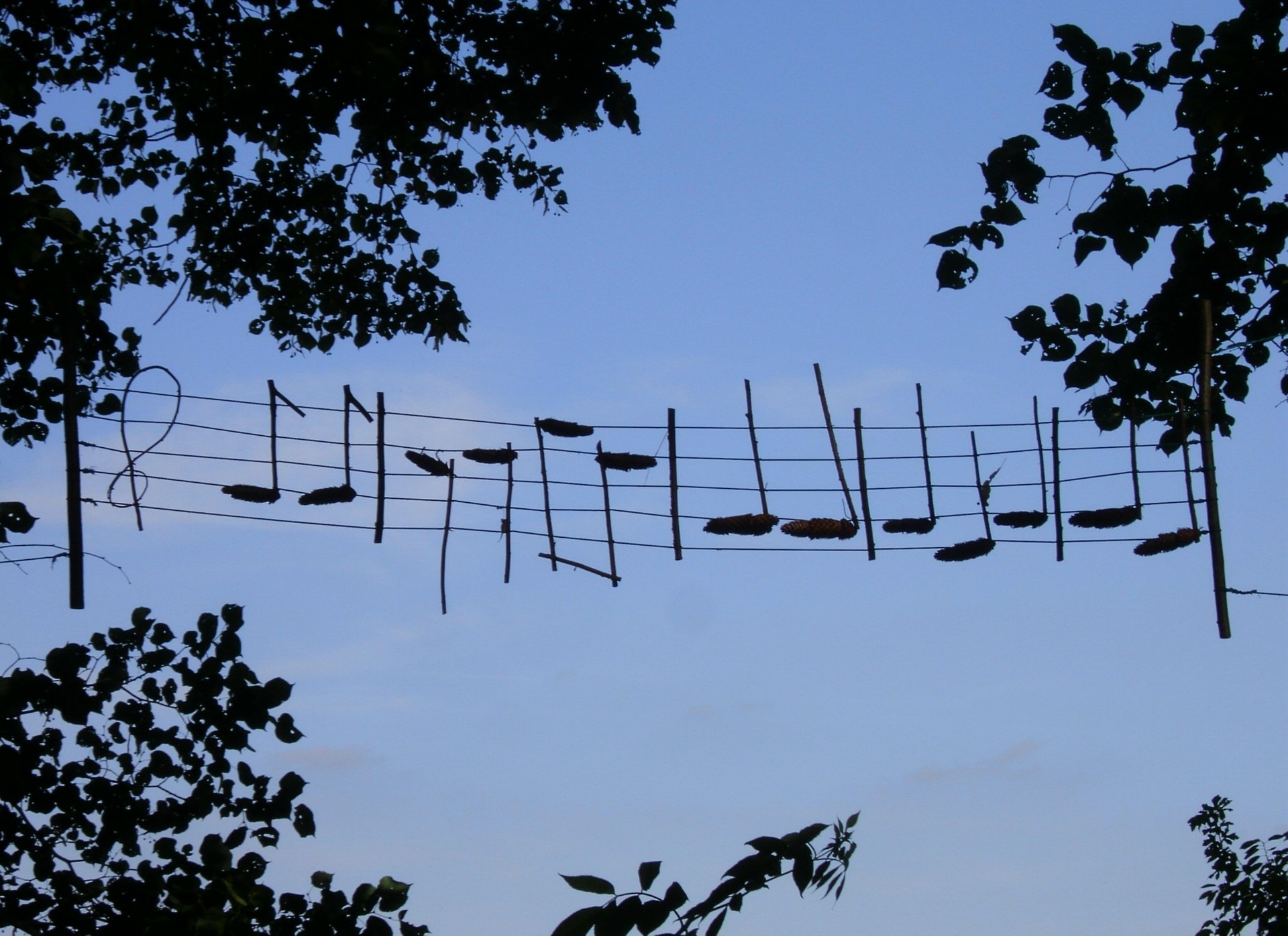Counting Beats in Music
Using Words To Know Where The Beats Go
Counting beats in music is a very important skill whether you're reading music or playing music. You need to know how to count in both.
What you don't technically need to know if you're playing music (like piano chords for example), is all the rhythm symbols that match the beats. You definitely need to know that for reading music though!
If you'd like to do a quick refresher of the different symbols or refer to them at any point, check out the music rhythm symbols page.
Counting Beats in Music: Video Tutorial
Step 1: Know What Number You're Counting To
The first step in counting beats in music is to know or figure out what number you're going to count to.
If you have music in front of you, you'll have a time signature. The top number of the time signature is what we're counting to.
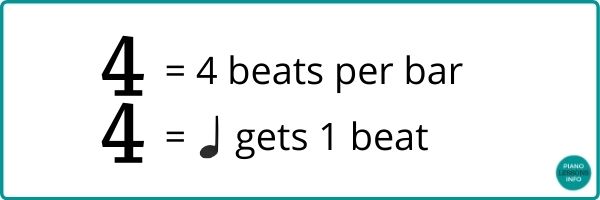
So for 4/4, we're counting to 4.
For 3/4, we're counting to 3.
For 6/8, we're counting to 6.
But what if you're not reading music?
Chances are you'll be counting to 4. That is the most common time signature. What you can do is listen for the strong beat - the loudest in a group - and see what you count until the next one.
It'll will likely be 4 (if you count 2, make it 4). It could also be 3 or 6. It's unlikely to be something else - but always possible.
What we're going to use for the example on this page is 4/4. So we're counting to 4!
Step 2: Count the Main Beats
In music, we have beats that are the foundation for our rhythm.
You can thinking of a steady drum beat here. That steady drum beat is the beat.
The main beats are going to fall on the number we say and if we're counting to 4, this will be 1, 2, 3, 4.
Main beats in 4/4 time: 1 2 3 4.
This is where we start having two different sets of numbers when reading music and it can get a little bit confusing sometimes.
We know that a quarter note gets 1 beat. And before you may have counted 1 1 1 1. Now we're changing this a bit. Within a bar or measure of written music (which has 2 lines on either side), we're going to say 1 2 3 4. One number for every quarter note because a quarter note gets 1 beat in 4/4 time.
Are you still with me?
If not, just think, we're going to count to 4. Each number is a beat.
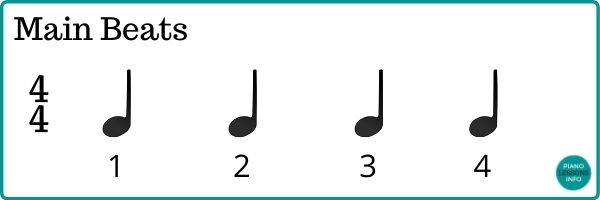
Step 3: How To Count In Between The Beats
Now that we know we're counting to 4, we can start working out how to count all the notes that don't fall directly on those numbers. There are multiple ways people can and do write music, so knowing how to count that out is very helpful!
Now when we get to this point, we're really going to focus on specific rhythm patterns that are written down. You don't need to count out rhythms as much if you are just playing piano chords. But if you wanted to, this is how you do it.
Using Words To Count In Between Beats
Counting 8th Notes
To count the beat in between a number - like beat 1 and beat 2 - we can use the word "and".
The "and" falls directly in the middle of the beats. This is equivalent to an 8th note.
To say it, you would say, "1 and 2 and 3 and 4 and".
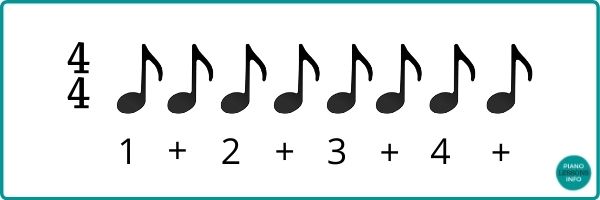
If you had a rhythm of 2 quarter notes and 4 eighth notes, you could count it out like this:
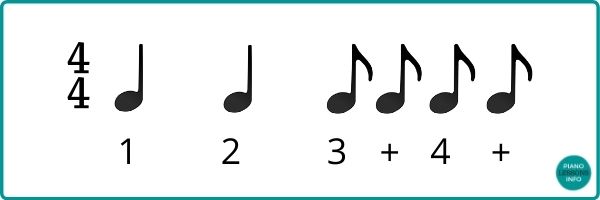
If you wanted to say the "and" every time to keep in strict time, you can. Just remember only to play on the "and" when you should.
Counting 16th Notes
If you have even faster notes than this - say 16th notes - we can say something else. I have always said, "1 e + a".
1 quarter note is equal to 4 sixteenth notes. And 2 eighth notes also equal 4 sixteenth notes. So we need to squish all of those in evenly to the same space the other notes would get.
We have the 1 to start the beat.
To play another 8th note, we'd hit a note on "and".
To play 4 sixteenth notes though, we need to fit in another note after 1 and another after "and".
So sixteenth notes would play on 1 e + a.
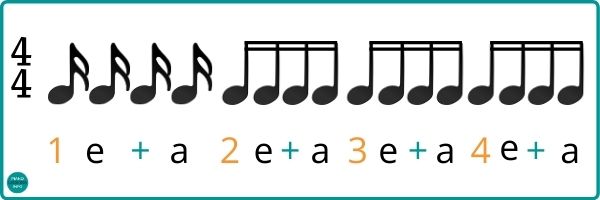
How to Count Long Notes
When you have notes that would be longer than a quarter note, you hold them for however many beats that note would get. You can still count the beats the same - just remember to hold it.
For a half note, you'd hold it for beats 1 2.
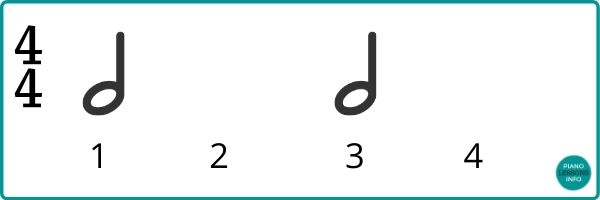
A dotted quarter note would get the counts 1 2 3.
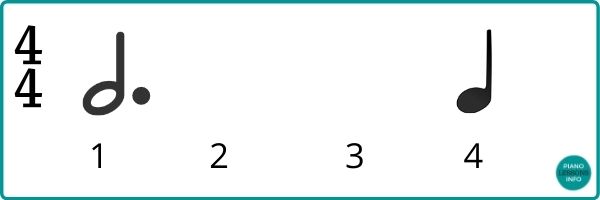
A whole note would get beats 1 2 3 4.
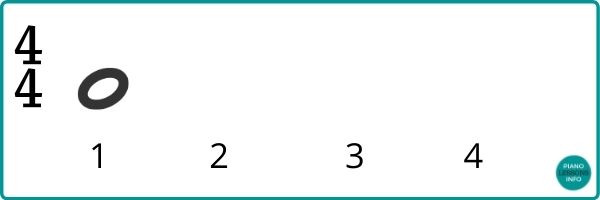
Now we can mix and match.
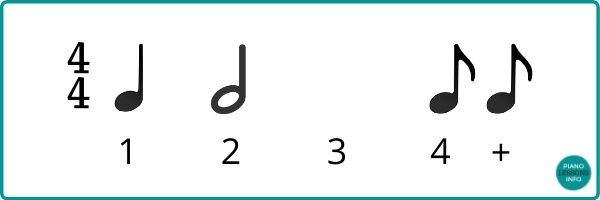
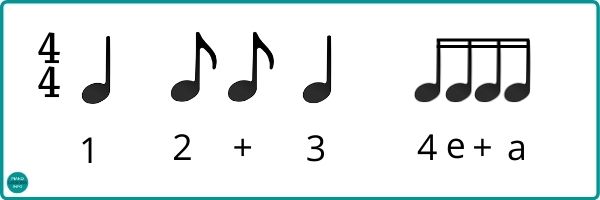
Quick Summary of Counting Beats in Music
In 4/4 time, we're going to count to 4. Each number is equivalent to a quarter note.
In between the beats, we can say "and". Saying "1 and" is equivalent to two 8th notes.
We can say "1 e + a" to count 16th notes. Saying 1 e + a is equivalent to 4 sixteenth notes.
Counting Beats in Different Time Signatures
If we change the time signature, it changes how we count.
If you need a full run down on what time signatures means, check out the time signatures page.
Remember that the top number is the number we will count to. The bottom number stands for a specific note getting 1 beat. If it's a 4, that's a quarter note.
How To Count In 3/4 Time
In 3/4 time, we have 3 beats. We're going to count to 3.
The bottom note is a 4 so that means a quarter note gets 1 beat.
We can count everything else the same.
Quarter notes would fall on 1, 2, 3.
8th notes would fall on 1 + 2 + 3 +.
16th notes would fall on 1 e + a 2 e + a 3 e + a.
How to Count in 6/8 Time
Counting beats in 6/8 time is quite different from 4/4 or 3/4 because the bottom number has changed.
In 6/8 time, the bottom number refers to an 8th note. So an 8th note gets 1 beats. We are also counting to 6.
This means to each beat - 1 2 3 4 5 6 - is an 8th note.
We can still say "and" in between the beats. This "and" will be a 16th note.
What we've done is change the scale around. Each note doubles in value and we can just change which one means "1 beat".
In 6/8 time, a quarter note gets 2 beats.
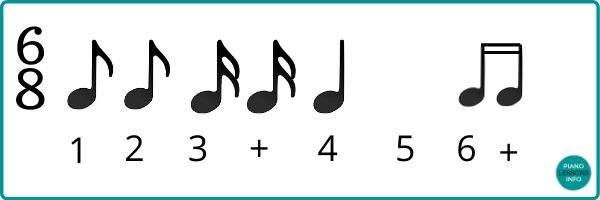 Counting Beats in 6/8 Time
Counting Beats in 6/8 TimeHow To Count in 2/2 Time
In 2/2 time, we will be counting to 2. For each bar, you can say "1 2".
The note that gets 1 beat has changed to a half note. The bottom number in the 2/2 time signature means that a half note gets 1 beat.
This means half notes would fall on 1 2.
Quarter notes would fall on 1 + 2 +.
8th notes would fall on 1 e + a 2 e + a.
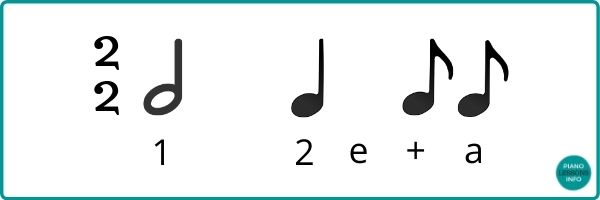 Counting Beats in 2/2 Time
Counting Beats in 2/2 TimeFree Download:
Ultimate Chord Cheat Sheet
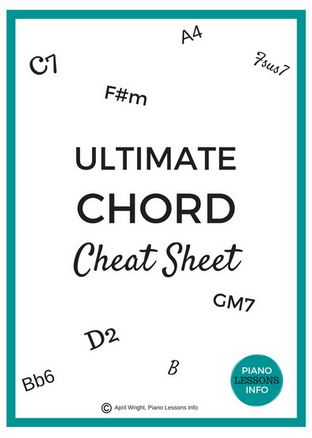
Subscribe below and get free access to the (printable) Ultimate Chord Cheat Sheet.
Those are the essentials on how to count!
Next: how to play rhythm patterns with piano chords!
Recent Articles
-
Piano Notes Chart
Nov 20, 23 10:21 PM
Find a piano notes chart for treble clef and bass clef notes as well as the different types of notes. -
D Chord on Piano + Diagram, How To & Theory
Oct 24, 23 12:20 AM
Learn how to play the D chord on piano with diagram, fingering, D/A, D/F# and a theory explainer. -
Diminished Piano Chords: Chart & How to Make Them
Oct 09, 23 09:23 PM
Learn the different diminished piano chords and how to make them. Here you'll find both a diminished chord chart and an explanation.
Free Download:
Ultimate Chord Cheat Sheet

Subscribe below and get free access to the (printable) Ultimate Chord Cheat Sheet.
